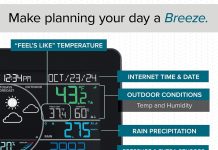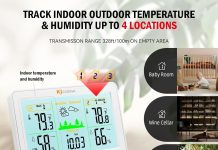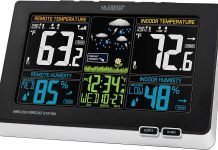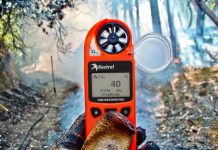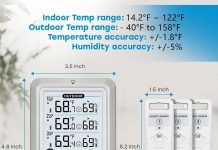Curious about what exactly the weather station rain gauge measures? Look no further. From the moment raindrops touch the surface of this specialized instrument, its intricate mechanisms kick into action, delicately capturing and calculating the amount of precipitation that falls from the skies above. In this article, we’ll uncover the fascinating world of rain gauges and shed light on how they provide crucial data for meteorologists, gardeners, and weather enthusiasts alike. Whether it’s a light drizzle or a torrential downpour, the rain gauge holds the key to understanding our ever-changing weather patterns.
Review contents
What Does The Weather Station Rain Gauge Measure?
Introduction
As weather enthusiasts, we are often curious about the various instruments used to measure weather phenomena. One such instrument is the rain gauge, a vital tool in assessing and monitoring precipitation levels. In this article, we will dive deeper into the world of rain gauges, exploring their components, working principle, measurement units, types, placement, accuracy, and maintenance. By the end, we hope to provide a comprehensive understanding of the purpose and functionality of rain gauges within a weather station.
Definition of Rain Gauge
At its core, a rain gauge is a meteorological instrument used to measure the amount of precipitation, particularly rainfall, in a specific area over a given period. It helps us quantify the amount of water that has fallen from the atmosphere onto the Earth’s surface. With accurate measurements, meteorologists, hydrologists, and climate scientists can better understand weather patterns, water resource management, and the impact of precipitation on our environment.
Components of a Rain Gauge
A typical rain gauge consists of several key components that work together to collect and measure rainfall. The primary elements include:
- Funnel: The top part of the rain gauge, designed to collect rainfall and channel it downward.
- Collector: Situated beneath the funnel, the collector receives the water flowing from the funnel.
- Measuring Cylinder: Located below the collector, the measuring cylinder collects and stores the rainfall for measurement.
- Scale: Attached to the measuring cylinder, it provides a visual representation of the accumulated rainfall in various units.
- Overflow Mechanism: To prevent overflow during heavy rainfall, a well-designed rain gauge incorporates an overflow mechanism, allowing excess water to escape while still collecting accurate measurements.
Working Principle of Rain Gauge
Understanding the working principle of a rain gauge helps us comprehend how it measures rainfall accurately. When rain falls, it naturally collects in the funnel at the top of the rain gauge. The funnel’s shape is carefully designed to ensure proper collection without significant loss due to wind or splashing. From the funnel, the water flows into the collector, and eventually into the measuring cylinder. As the water level rises within the cylinder, the scale attached to it allows for visual measurement of the accumulated rainfall.
Measurement Units of Rain Gauge
Rain gauges provide measurements in various units depending on the location and standard practices. Some common measurement units include millimeters (mm), inches (in), centimeters (cm), or sometimes even liters per square meter (L/m²). These units allow meteorologists to accurately report and compare rainfall across different locations and timeframes.
Types of Rain Gauges
Rain gauges come in various types, each suited for specific purposes and climates. Here are some commonly used rain gauge types:
- Standard Rain Gauge: The standard rain gauge represents the most common design and consists of a cylindrical measuring tube with a wide opening at the top.
- Tipping Bucket Rain Gauge: This type employs a small bucket mechanism that tips once a predetermined amount of rainfall is collected. It is widely used in automated weather stations due to its ability to provide real-time data.
- Weighing or Recording Rain Gauge: These advanced rain gauges utilize sensors to measure the weight of the collected rainfall continuously. They are highly accurate but typically more expensive.
- Optical Rain Gauge: Often used in research and climate studies, this type measures rainfall by detecting the attenuation and scattering of light caused by raindrops.
Placement of Rain Gauge
To obtain the most accurate measurements, it is crucial to carefully choose the location for installing a rain gauge. Ideally, the rain gauge should be placed in an open area, away from any structures or trees that could obstruct rainfall collection. A flat, level surface free from debris and vegetation ensures the rainfall is not contaminated or altered. Additionally, the rain gauge should be positioned a safe distance from nearby objects that may cause splashing or wind interference.
Accuracy of Rain Gauge
The accuracy of a rain gauge is of utmost importance to ensure reliable data. Regular calibration and verification against known standards are essential to maintain accuracy. Additionally, it is crucial to consider potential errors due to wind effects, evaporation rates, and blockages in the collection system. By implementing proper maintenance and calibration procedures, users can increase the accuracy of their rain gauges and contribute to more reliable weather data.
Maintenance of Rain Gauge
Proper maintenance is vital to ensure the longevity and accuracy of a rain gauge. Regular checks for debris, dust, and contamination in the collection area are necessary. Cleaning the measuring cylinder, removing any leaves or dirt, and verifying the scale’s integrity contribute to accurate measurements. Periodic calibration and comparison with other rain gauges in the area can also help identify any potential issues and ensure optimal performance.
Conclusion
A rain gauge is an essential instrument within a weather station, providing invaluable data on rainfall patterns and precipitation levels. By understanding its components, working principle, measurement units, types, placement, accuracy, and maintenance, we gain a comprehensive understanding of how rain gauges contribute to meteorology, hydrology, and climate science. Whether you are a weather enthusiast, a scientist, or simply curious about the world around you, the rain gauge plays a crucial role in unraveling the mysteries of precipitation and its impact on our planet.


